16 Colossi, 16 Shots: An analysis of Shadow of the Colossus' opening cutscene
More than ten years after its release, Team Ico's Shadow of the Colossus continues to entertain and inspire. This shot-by-shot analysis breaks down the game's opening cutscene to better understand how its minimalist narrative was achieved.

Shadow of the Colossus (2005). Developed by Team Ico. Published by Sony Computer Entertainment. Directed by Fumito Ueda.
INTRODUCTION
Since its release on the PlayStation 2 in 2005, Team Ico’s Shadow of the Colossus (henceforth: SotC) has been praised by fans and critics for creating a rich, satisfying player experience.
Players assume the role of Wander, a young warrior who must find and defeat sixteen colossi, scattered around a world largely devoid of other creatures (apart from lizards, birds, and the occasional turtle), to bring a woman, Mono, back from the dead. Wander is accompanied on this quest by his faithful horse, Agro.
Many have noted the game’s minimalism, both in its narrative and design. SotC has only a few key story moments, and these are delivered through semi-interactive cutscenes (which the player can choose to skip) and a brief narration following the start of a new game, all rendered in real-time using the game’s engine.
With relatively little explicit story, the game relies on its mechanics and art direction to create enough implicit context to engage players’ imaginations and set a strong emotional tone.
The rest of the story is told through the in-game camera as it follows Wander across a landscape littered with ruins, in a series of short monologues delivered by a disembodied and seemingly omniscient voice called Dormin that preface each colossus, and in the lead up to and during the battles with the colossi themselves.
There are no other enemies aside from the colossi and, except for a Time Attack mode and increased difficulty unlocked upon completion of the game, there are no sidequests or additional challenges. This stands in stark contrast to the reams of objectives, dialogue, and lore found in similar epic fantasy adventures[1].
At this point I should mention that SotC’s story is an archetypal “save the princess” tale, which at times uses outdated gender roles and gives Mono, its lone female character, little to no agency. While it also subverts aspects of the male power fantasy over the course of the game, it has still drawn criticism for its representation of women.
While there are many reviews and critical essays focused on these general aspects of SotC, including a book by Nick Suttner[2], one thing I haven’t yet found is a film school-style shot-by-shot analysis of the game’s introductory cutscene[3].
Cutscene breakdowns are rare in video game criticism. There may be many reasons for this, chief among them that cutscenes are not gameplay; they are a tool borrowed from another medium (i.e. film), and are the passive component of an otherwise active experience. They are often utilitarian, inserted to provide a narrative context for the player’s actions, or connect one section of gameplay to another, or serve as a reward and rest period after a difficult challenge. And for a long time during the early days of 3D graphics they were very rudimentary, essentially reducing the art of cinema to a low-poly puppet show.
Shadow of the Colossus is different. The game’s director, Fumito Ueda, and the developers at Team Ico clearly understand, and heavily rely on, the visual language of film. Ueda’s philosophy has been described as “design by subtraction”[4], that is removing any element not essential to the experience, and that philosophy is evident from the first cutscene until the game’s final credits. Every image is carefully composed and designed to convey meaning. While SotC’s introduction would function well as a film, its brilliance is in how it sets up everything that follows in the game.
On a personal note, I’ve always admired both Ico and SotC, and have a longstanding interest in how minimalist narratives are constructed. I also wanted to replay the game, albeit with a more critical eye, prior to the release of Team Ico’s latest game, The Last Guardian (which finally arrived in December 2016, after almost nine years in development).
But more than that, I believe there are lessons here that can be applied when considering our own narratives. So often we equate stories with words, and cutscenes with long, non-interactive sequences that many players would rather skip. While the techniques used in SotC will not fit every project, on a broad level game stories can greatly benefit from the power of visual storytelling, focusing on strong graphic composition, allowing players to drawn their own inferences rather than overtly explaining every detail, and, ultimately, making every second count.
ANALYSIS
This sequence is a montage showing Wander’s journey to the Forbidden Lands. It consists primarily of wide, high angle and medium, eye level shots; the former establish the character’s relationship to the vast landscape while the latter serve to cement the viewer/player’s connection to Wander and Agro. Overall, the pacing feels slow and methodical, matching the horse’s relaxed walk. They are on the move, but are not being pursued.
The sequence can be further divided into four sections, in which the geography maps to a specific mood:
Section 1: The Ravine – Danger
Section 2: The Forest – Dreaming
Section 3: The Rain – Resting
Section 4: The Gate – Crossing the threshold
The camera is always in motion – except for two shots in the third section – relying heavily on dolly shots tracking the characters, which serves to emphasize the concept of travel. While the focus mostly remains on Wander and Agro, the landscape in frame often changes between the beginning and ending of a shot, again highlighting movement through space. Wander’s direction of travel remains largely consistent from frame right to left.
The cutscenes were previously described as “semi-interactive”, since the player retains control to adjust the framing of each shot within a limited window. Possibly this was done to provide a little interactivity during what would otherwise be a completely passive sequence. There is a strong possibility players will still be holding the controller by the time the main menu appears, rather than having put it down to simply watch. And while the potential exists to cause the camera to bob and sway drunkenly, thus undercutting the emotional impact, again I suspect that because of the connections it works to create, players will have invested themselves in the role and “play along” for the sake of a cohesive experience.
The only sound is an orchestral score composed by Kow Otani.
One final note: This cutscene contains the same number of shots as colossi. I can only speculate whether this is intentional or coincidental. In a game with equally as many deliberate design decisions as unrealized ambitions and hidden test content, arguments could be made for both.
The following images are taken from The Ico & Shadow of the Colossus Collection, a remastered version of the game released in 2011 for the PlayStation 3.
Number of shots: 16
Total duration: 3m 33s
SHOTS
Shot #1
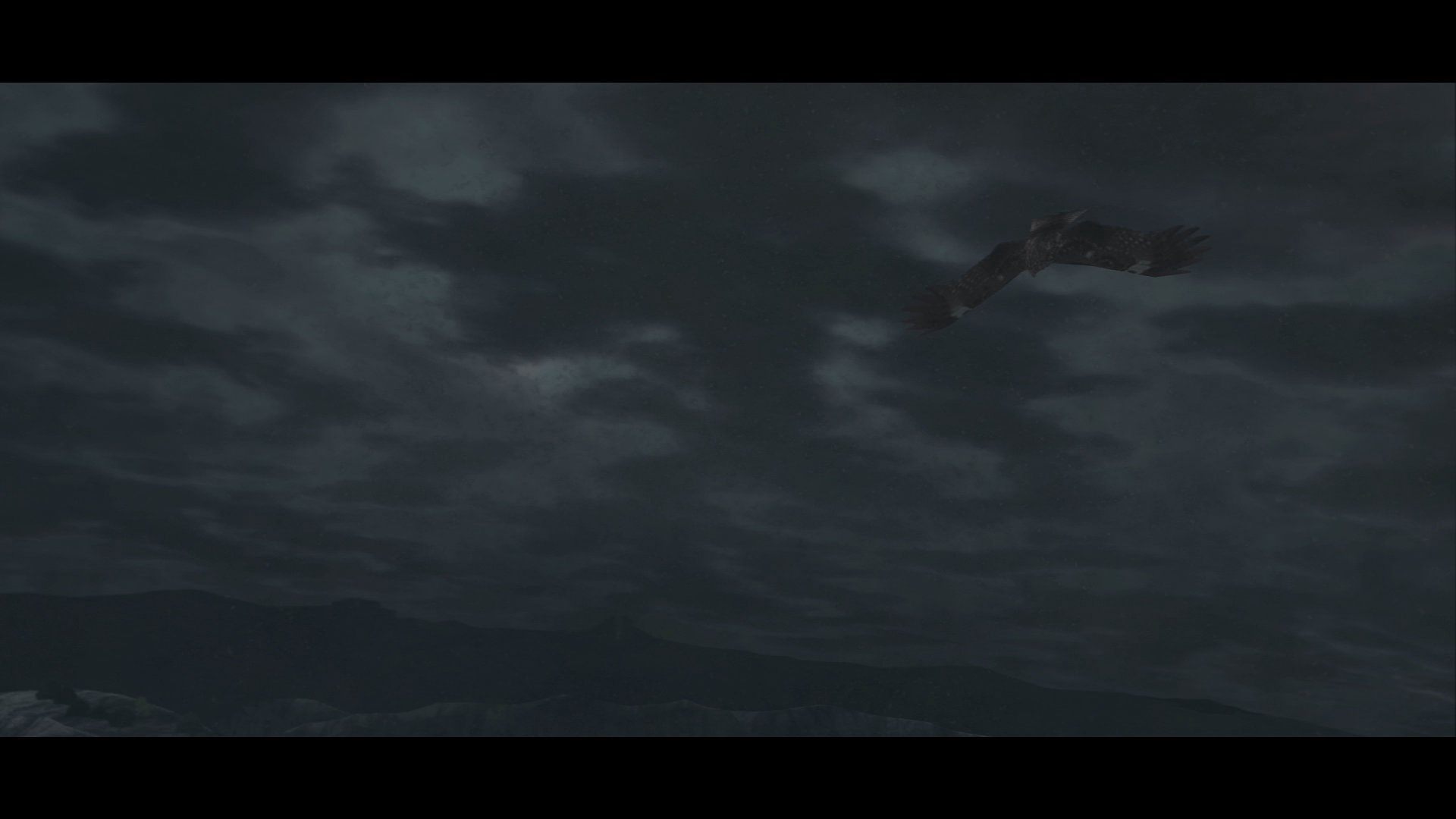
Duration: 28s
Shot type: Wide/establishing
Camera angle: Bird’s eye view
Camera movement: Tracking (following)
Transition: Invisible cut
Description: A cloudy, moonlit night sky fills screen, with a ragged strip of landscape in silhouette at the bottom third. A hawk flies into frame from the upper right. The camera follows it as it drifts into a ravine, hugging the right rock wall. At the nadir of its swoop, it approaches a lone figure (Wander) on a horse (Agro).
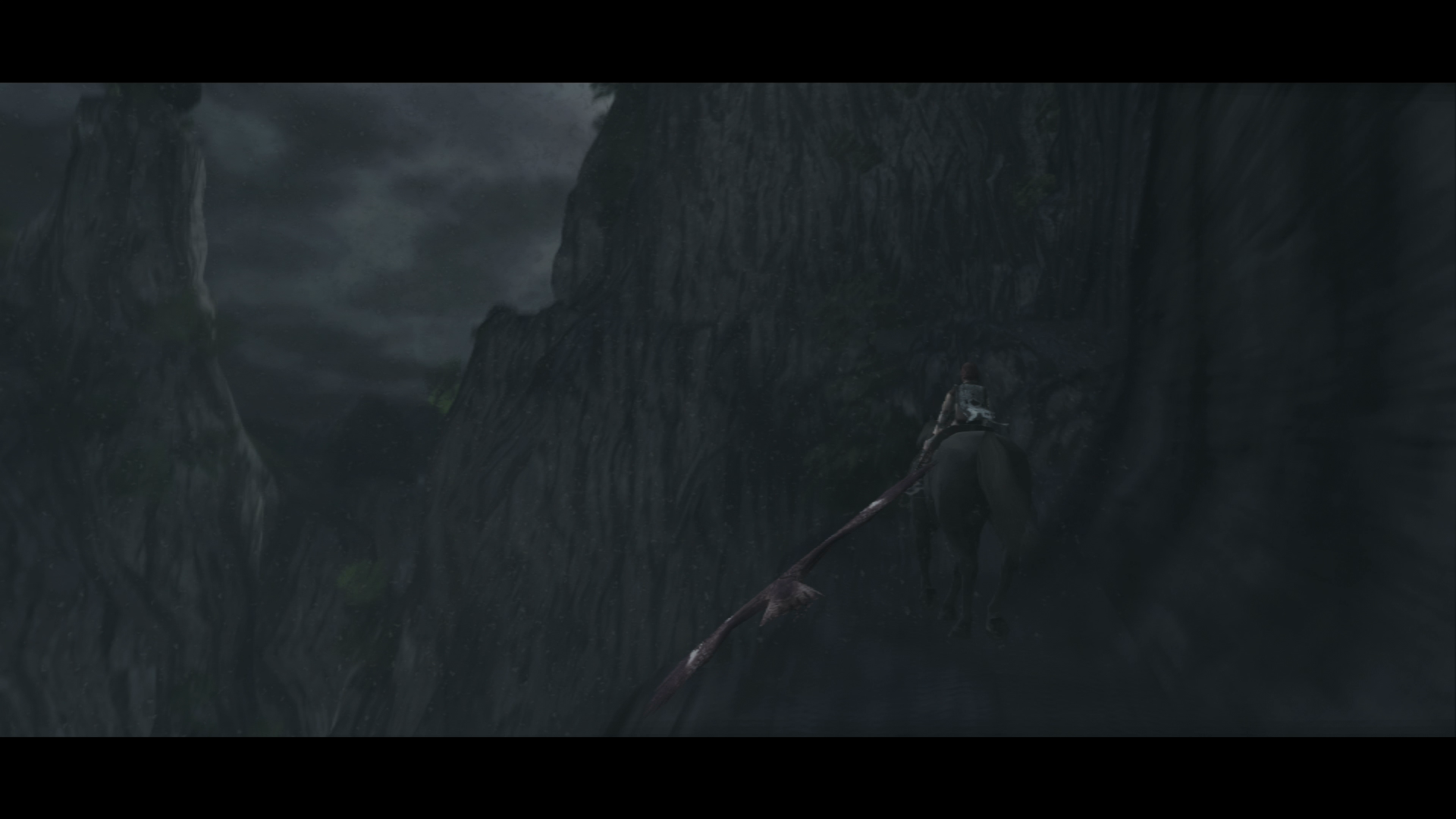
Notes: SotC’s establishing shot is a literal bird’s eye view of the terrain leading to the Forbidden Lands. The hawk is a both a bookend and a motif; it appears in the final shot of the last cutscene which plays behinds the credits, while various others follow Wander as he rides toward each colossus.
According to a fan translation[5] of the official art-book, released in Japan in 2006, Ueda says, “The ending then continues on to the opening. The bird takes flight, the weather turns to thunder, the moon comes out, and you’re returned to the opening movie. The ancient land’s seal has been broken by Wander’s coming, and time, once stopped, begins to flow again.”
Keen observers will also observe the shape of the gateway to the Forbidden Lands, which appears as a small cleft at the horizon.
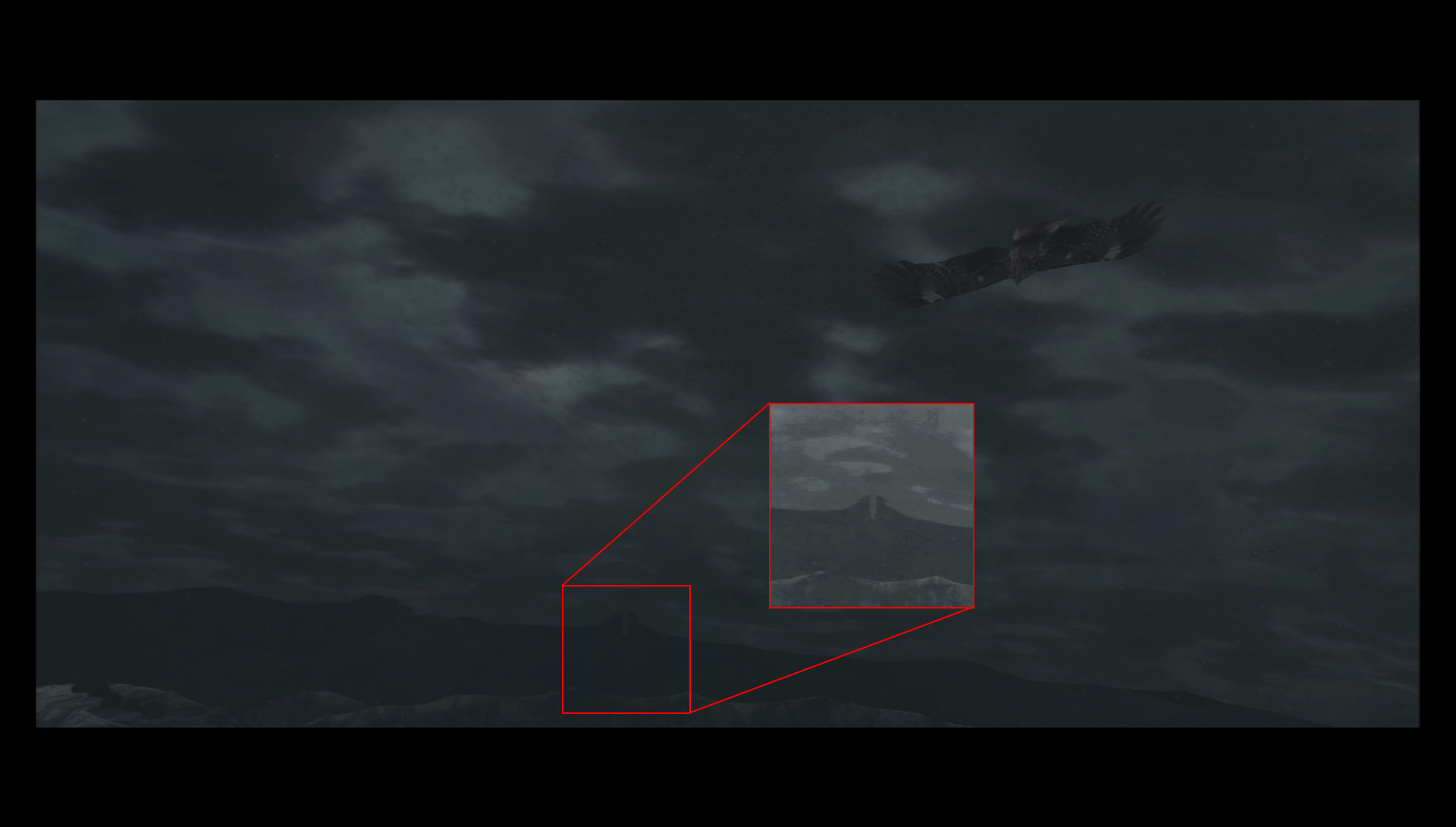
Because there are so few man-made structures in SotC, those that do exist gain additional significance, although this one, from this angle (the approach), only ever appears in the cutscenes.
Shot #2
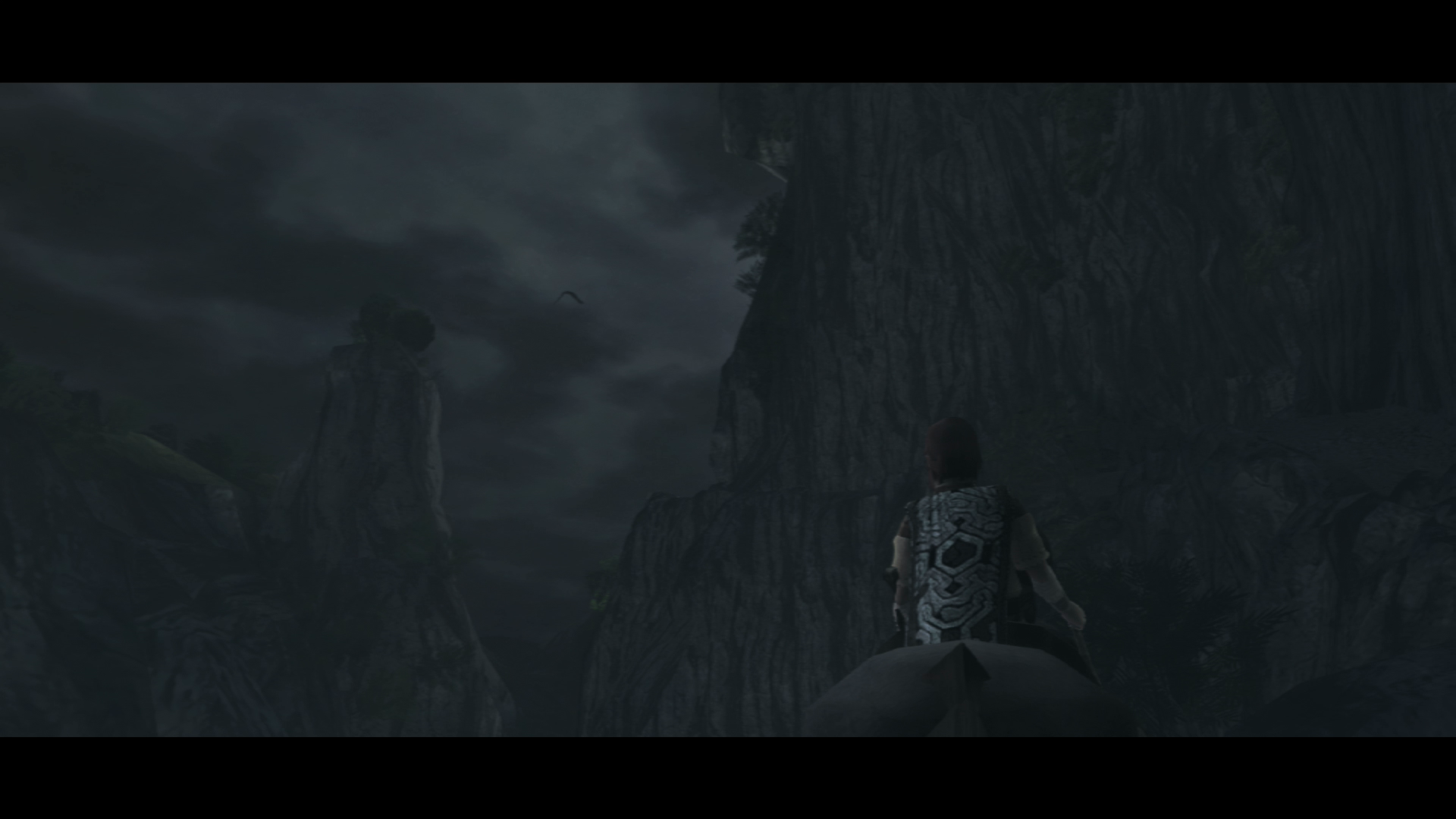
Duration: 11s
Shot type: Wide/medium
Camera angle: Eye level
Camera movement: Tracking, panning
Transition: Cut
Description: As the hawk passes Wander, nearly grazing his shoulder, the focus is transferred from the bird to the boy. The camera tracks right (behind the rider), stops, then pans slightly left as he watches it fly off into the distance. As the shot ends, Wander flicks Agro’s reins to continue moving.
Notes: This is supposed to feel like one continuous shot from the previous, but there is a distinct, almost invisible, cut between the two.
Its purpose in the sequence is to introduce Wander and communicate to players “This is you.” by rapidly changing the subject from the hawk.
Interestingly, throughout the entire cutscene, Wander is only ever seen from the back or in profile at a distance, never facing. One reason for this, perhaps, is to subtly establish early on that the third-person, over-the-shoulder perspective, is the default camera position during gameplay.
Additionally, the tabard Wander wears features similar sigils to those later found on the colossi (detail below).
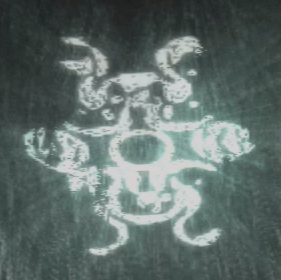
Shot #3
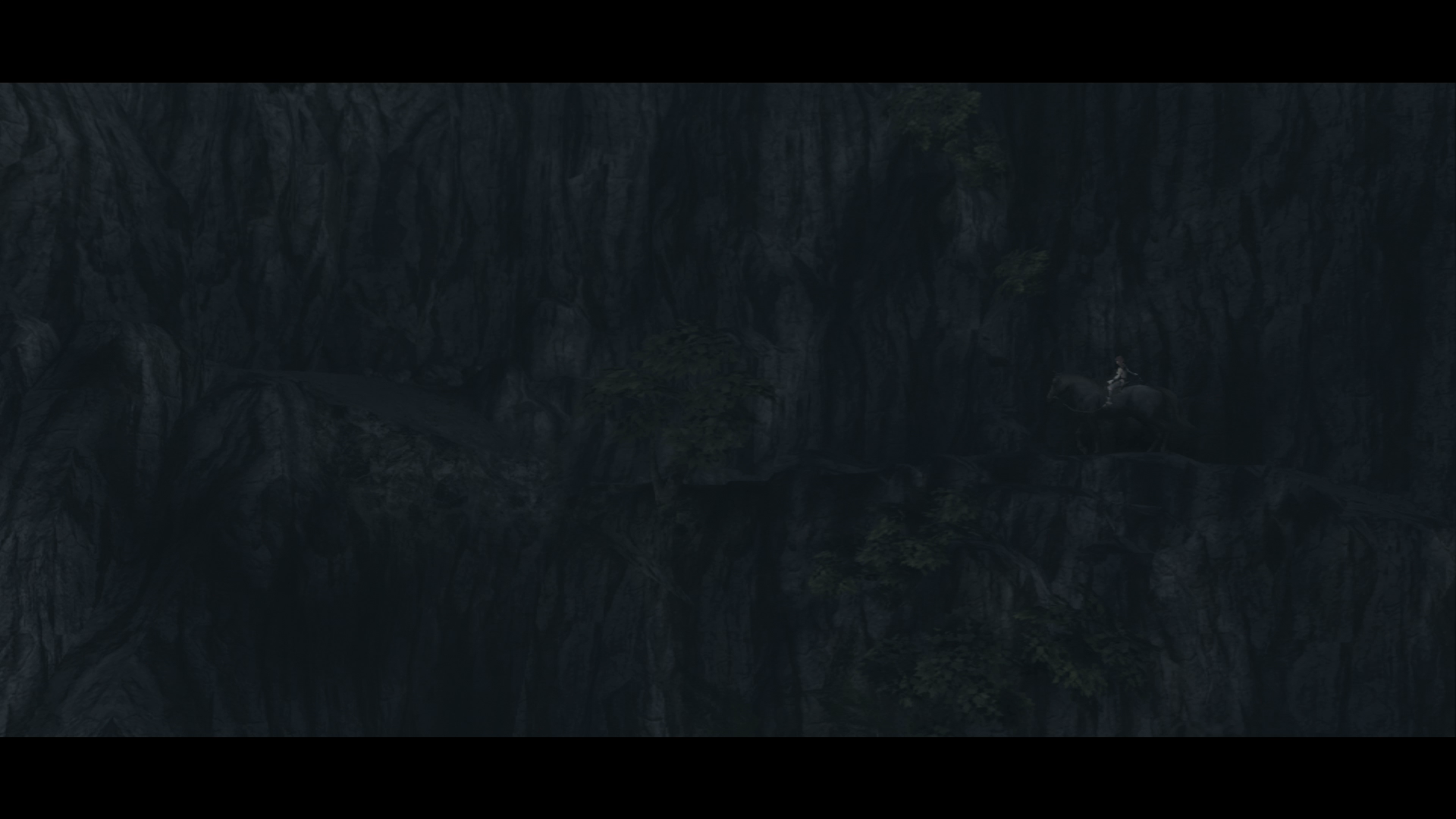
Duration: 6s
Shot type: Very wide
Camera angle: Eye level
Camera movement: Tracking (following), crane
Transition: Cut
Description: Wander continues along the path. The camera tracks left and raises slightly.
Notes: This brief shot serves to reinforce something shown in Shot #1, that the ledge Wander and Agro are on is high and narrow, which will be further strengthened in the following shot (#4). The sheer rock wall which dominates the frame makes the two seem small in comparison.
Shot #4
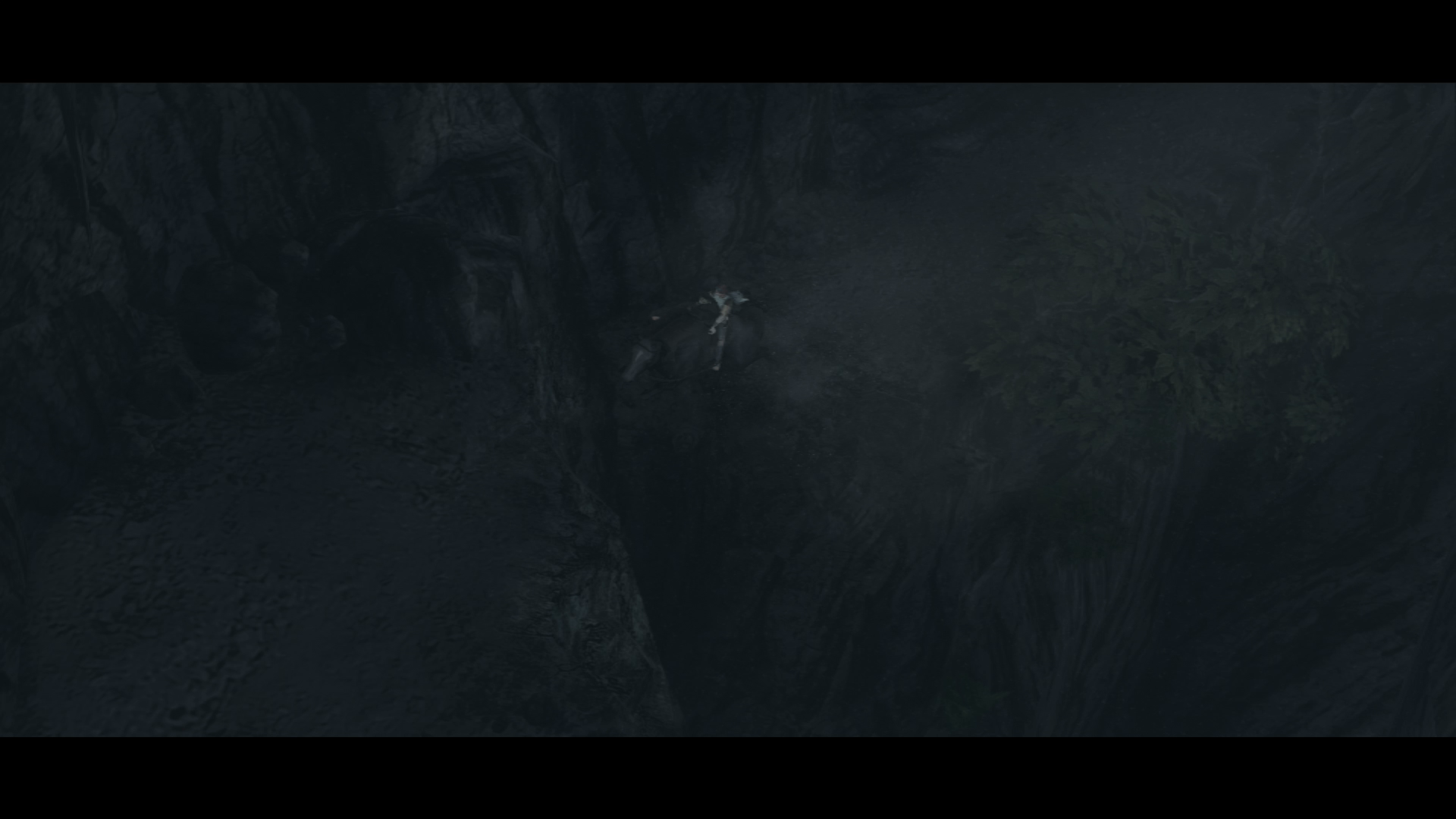
Duration: 16s
Shot type: Very wide
Camera angle: High
Camera movement: Crane
Transition: Cut
Description: Continuing from the previous shot (#3), the camera continues to rise and tilt down. Wander and Agro near a break in the path. Agro seems to study it, take a few paces back, then Wander spurs her to make the leap. Rocks tumble down as they land on the other side. Wander urges her on as the camera continues to turn and tilt downward to show the yawning chasm with no bottom in sight.
Notes: Not only is the ledge narrow, the camera’s high angle and downward focus hammer home the sheer height. Now added is an element of danger, represented by the gap. While Agro is able to cross it without much difficulty, it shows the trail they’re on is not maintained and likely not often traveled.
This is also the first hint of a third character. Sharp-eyed observers may notice a dark, hooded bundle across the saddle in front of Wander: Mono’s corpse.
Shot #5
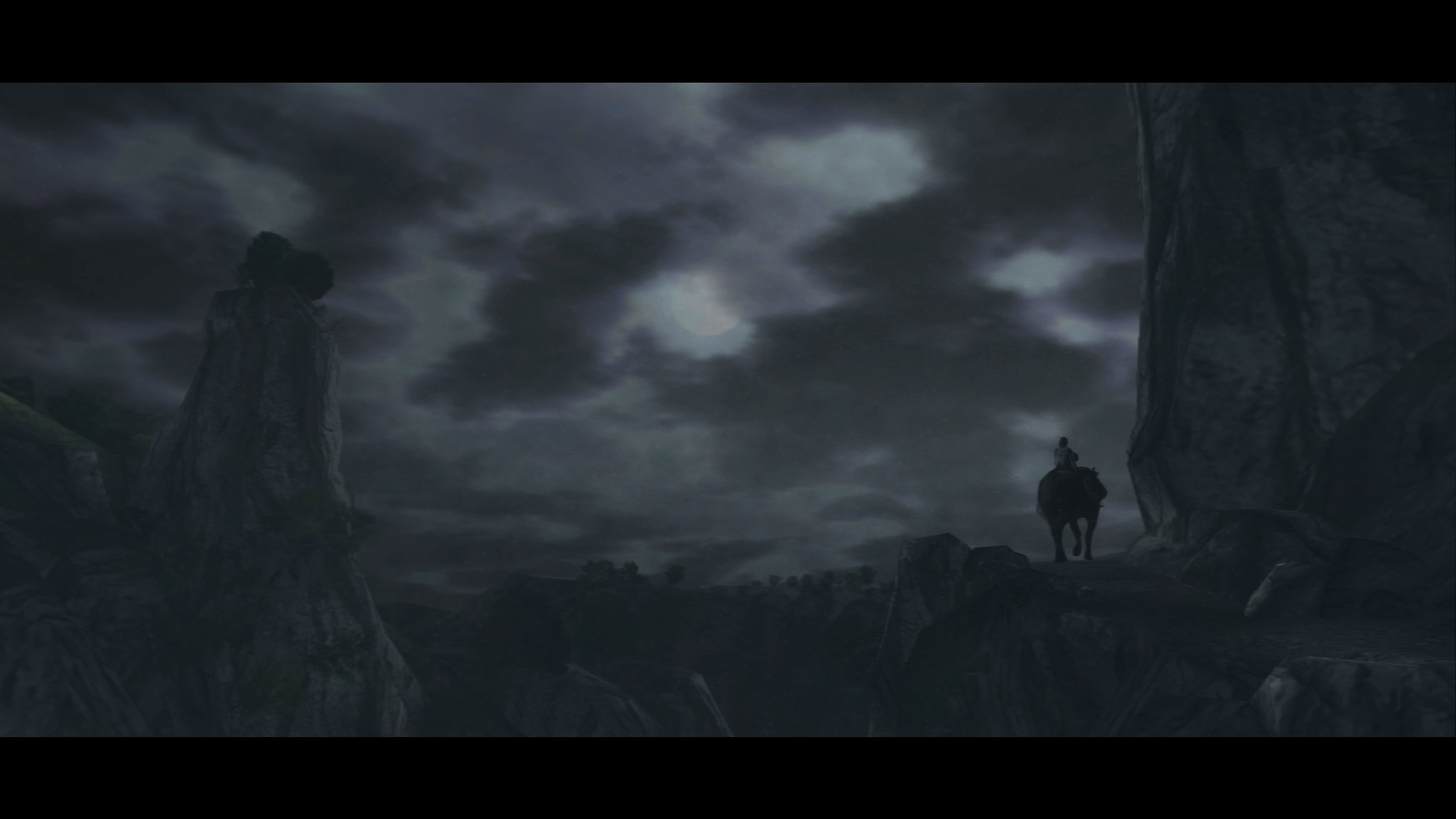
Duration: 11s
Shot type: Very wide
Camera angle: Below eye level
Camera movement: Panning
Transition: Fade to black. (The fades used throughout this cutscene are very fast, about 0.25s)
Description: From the start of the shot, the camera pans up and to the left. Wander and Agro continue along the path until they disappear around a bend. The camera lingers for a moment, then fades to black.
Notes: This is the final shot of the ravine portion of the journey, and acts as a transition to the next section. Aside from its strong visual composition, man and horse framed between two vertical pillars of rock with the full moon lighting up the clouds in the center, there isn’t much else to note.
Shot #6
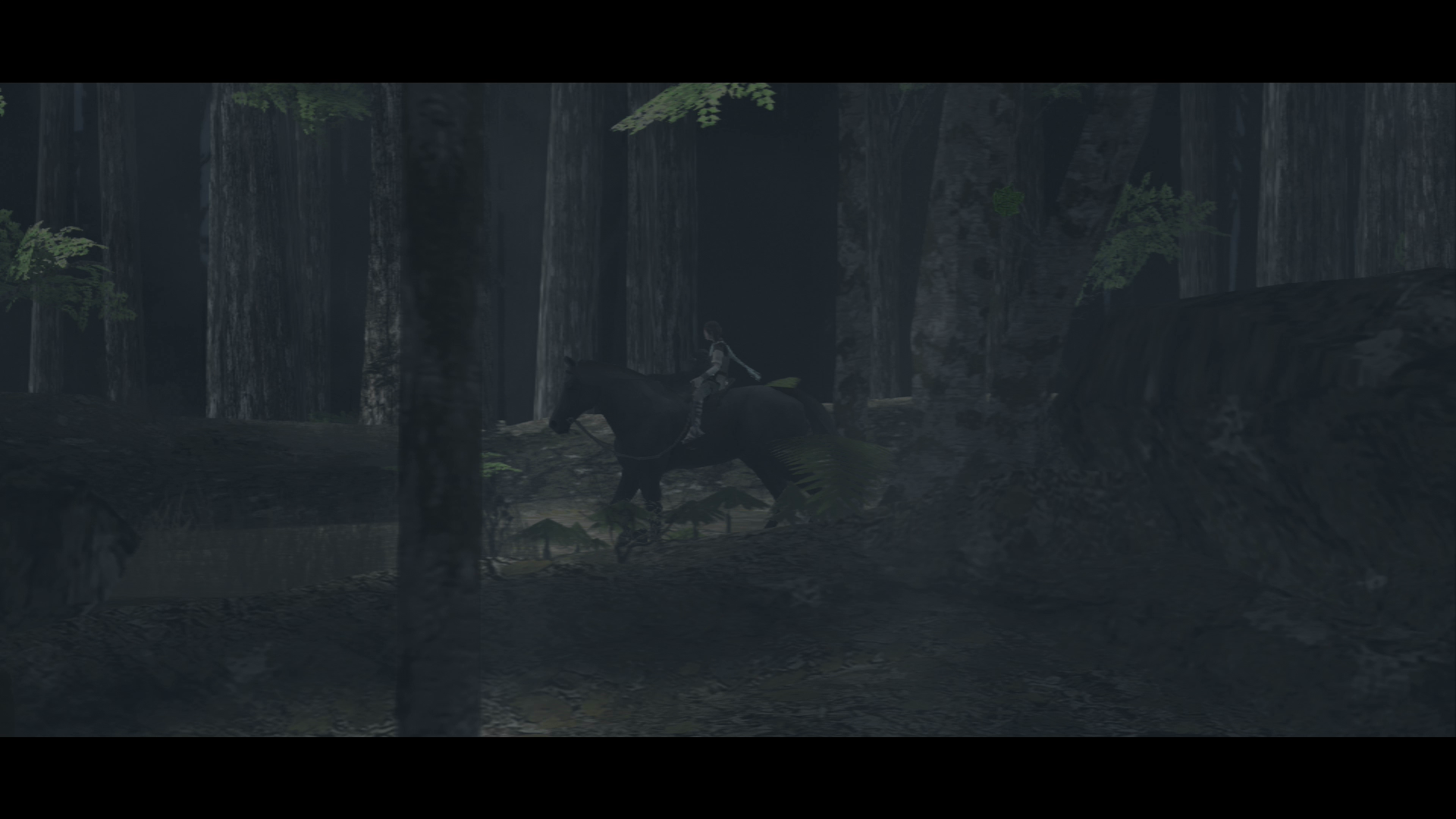
Duration: 10s
Shot type: Wide
Camera angle: Eye level
Camera movement: Tracking (following)
Transition: Cut
Description: The camera tracks left, following Wander and Agro through a forest. Occasionally rocks and trees fully or partially obscure them from view.
Notes: The fade from the previous shot denotes a jump in time and space. This is further evidenced by the location and lighting. We’re somewhere else now, farther along, making progress.
The vertical tree trucks in the foreground and deep forest in the background create a visually interesting parallax effect.
Again, the bundle containing Mono can be seen slung in front of Wander.
Shot #7
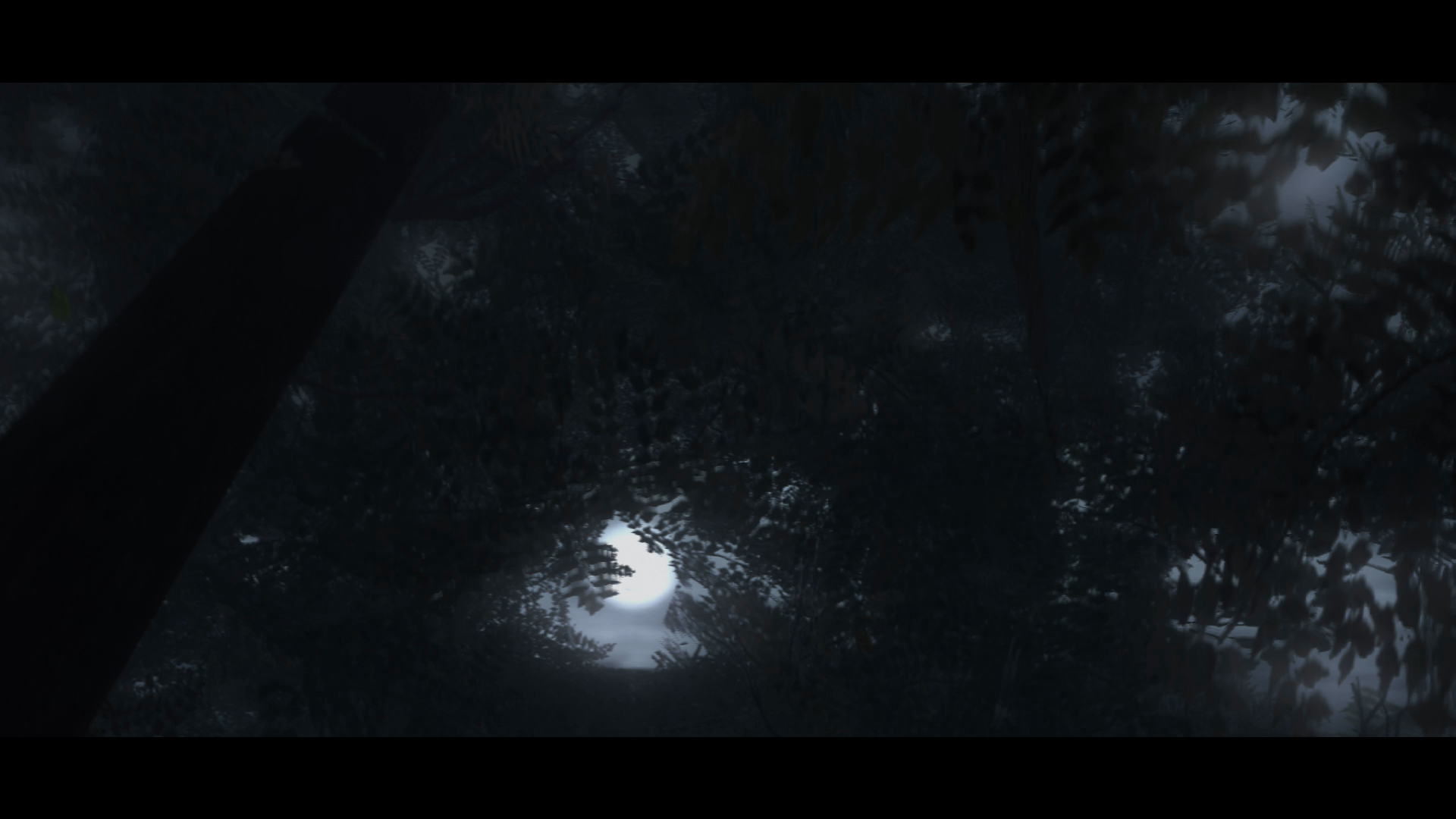
Duration: 8s
Shot type: Detail (possibly point-of-view)
Camera angle: Low
Camera movement: Tracking
Transition: Cut
Description: The camera is pointed almost straight up, with leafy branches passing overhead. At one point, the full moon is visible through a hole in the canopy.
Notes: I find this shot’s inclusion fascinating. If this is a POV, then it is the only time in the game the player sees the world from the first-person perspective, and one can easily imagine Wander leaning back in the saddle to stare up at the sky.
If it’s simply a detail shot, then the soft-focus filter on the leaves gives the scene a dream-like quality.
In either case, this section creates a feeling that SotC is more like a fairy tale than an heroic fantasy.
Worth noting, however much time has passed between this shot and Shot #5, the moon has not changed phase.
Shot #8
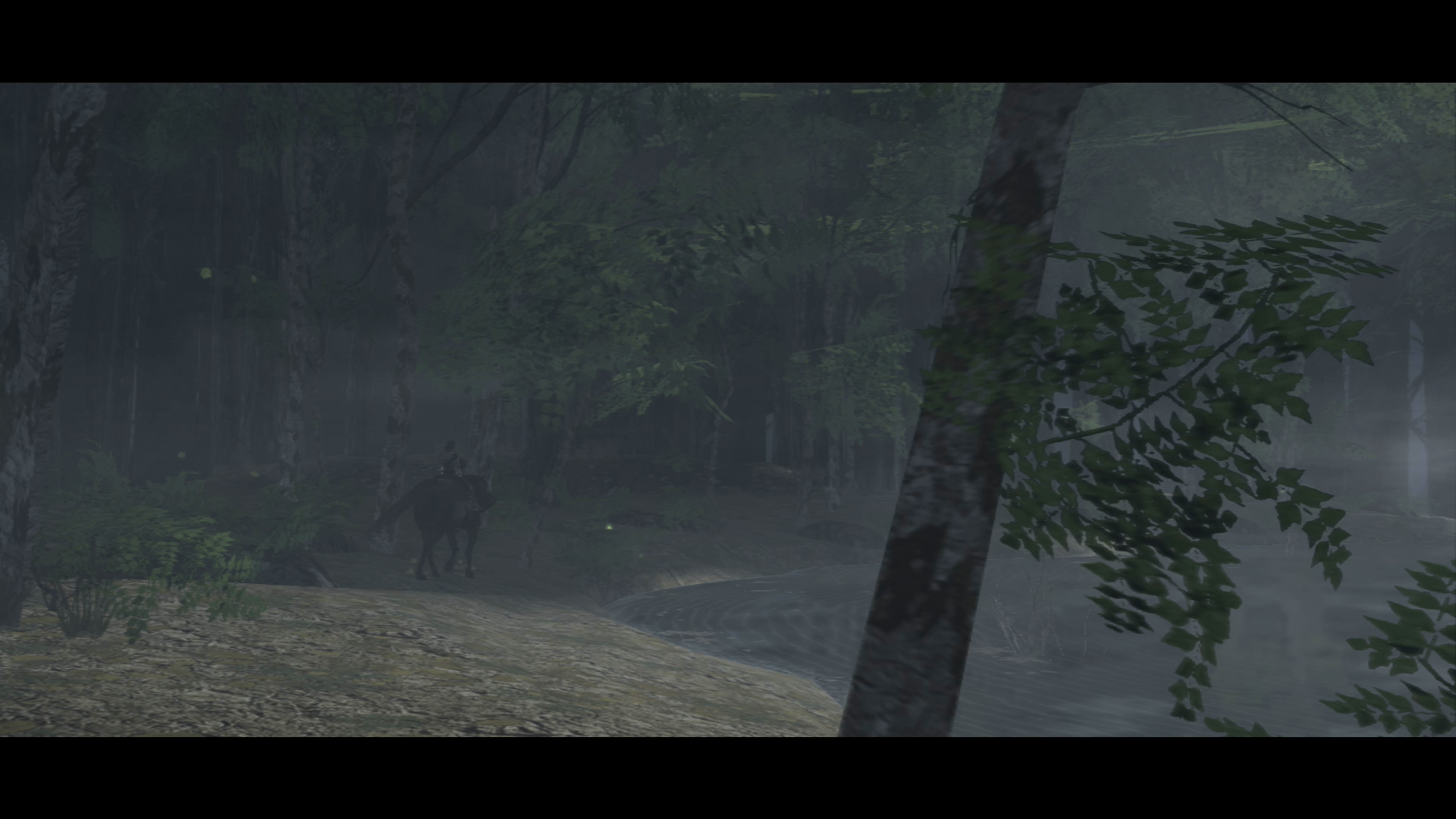
Duration: 12s
Shot type: Medium close up to very wide
Camera angle: Eye level
Camera movement: Panning, tracking
Transition: Fade to black.
Description: The shot begins focused on Agro’s hooves kicking up leaves on the ground by a small body of water. The camera pans up and dollies back as the characters continue around the edge of the pool.
Notes: Like Shot #5, this serves as a transition between the forest section and the next.
The fog and falling leaves lend this shot the same dream-like atmosphere as the previous (#7). The addition of the water strengthens the folkloric quality of the image, as legends involving a secluded glade with a mystical pool are common in mythology (though, in European myths, these are often portrayed as spaces of darkness or temptation).
Shot #9
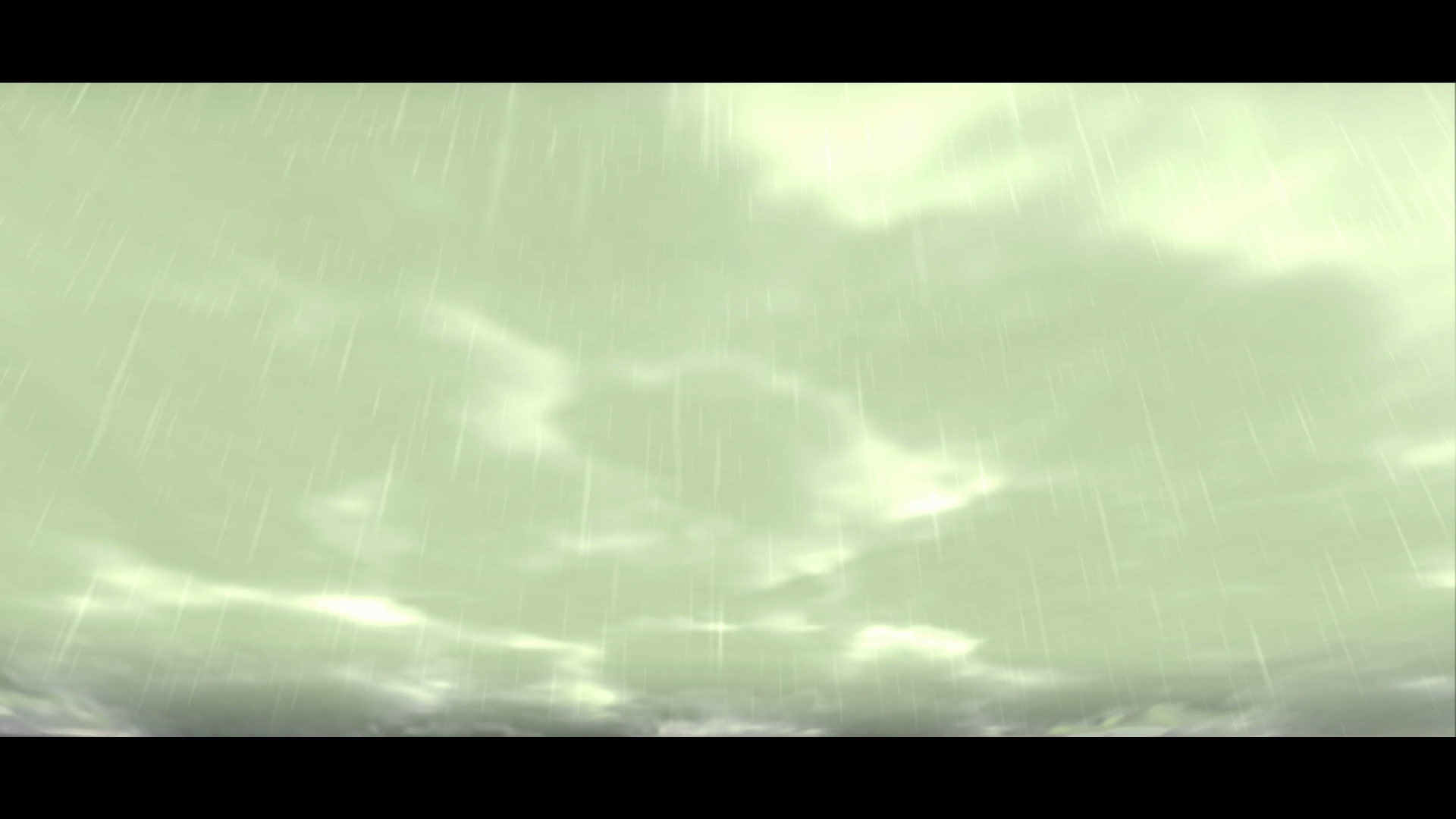
Duration: 7s
Shot type: Weather
Camera angle: Low
Camera movement: Fixed
Transition: Cut
Description: A low angle shot looking up into a cloudy yellowish sky while rain pours down. The only movement in the shot is the falling drops and a thin strip of grey clouds drifting right to left at the bottom edge of the frame.
Notes: This is the first of only two static shots in the cutscene (the other immediately following).
The fade from the previous shot, as well as the change in weather and time of day, signals again that time has passed and, even though he’s not shown, Wander has continued to progress toward the Forbidden Lands.
As a symbol, rain can potentially represent different moods, both positive and negative, like gloom and unhappiness or cleansing and rebirth. I choose to interpret the rain as representing stasis or rest, a brief respite in Wander’s relentless march toward his goal.
Shot #10
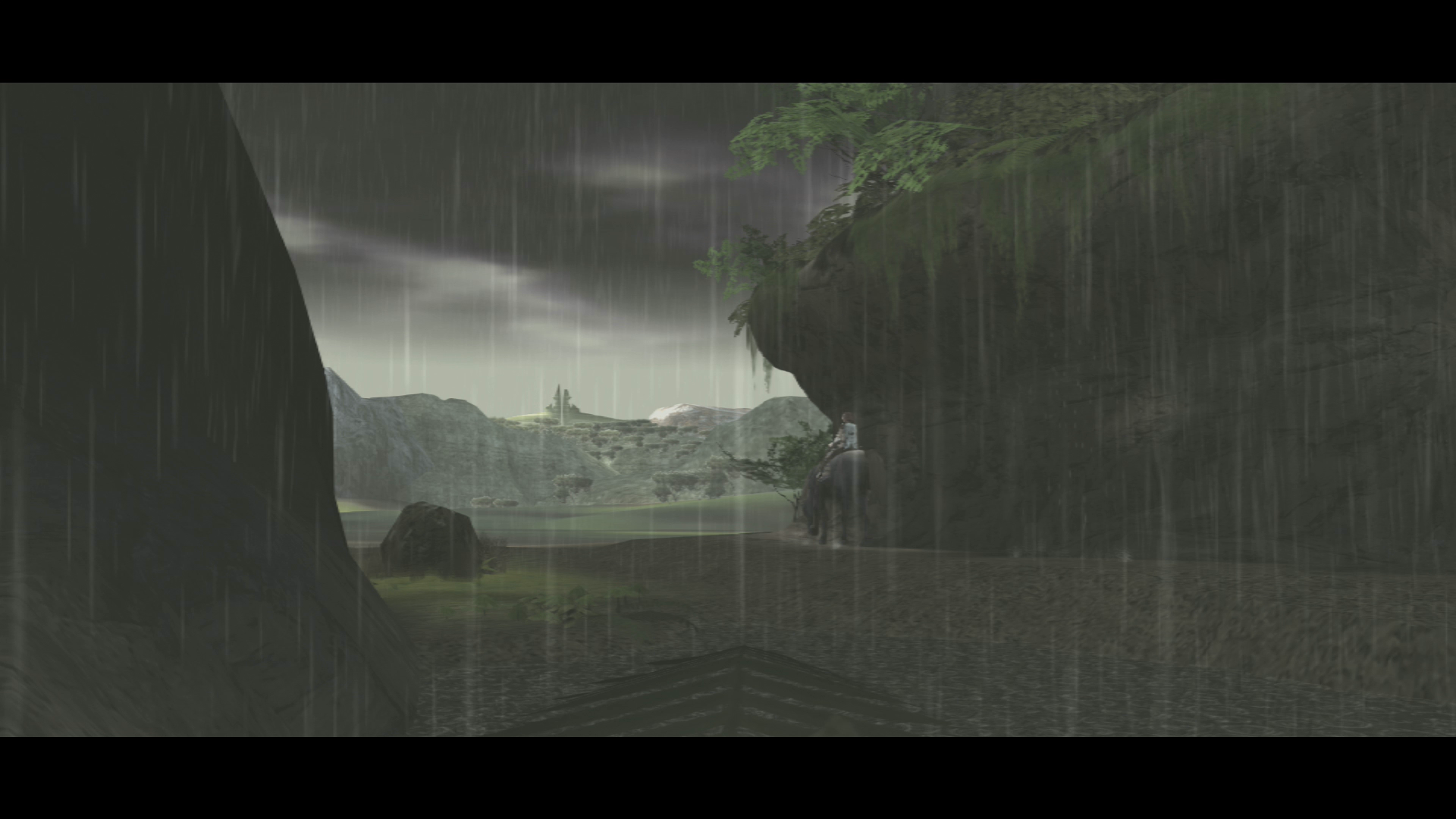
Duration: 4s
Shot type: Very wide
Camera angle: Eye level
Camera movement: Fixed
Transition: Cut
Description: Wander and Agro are sheltered from the downpour by an overhanging rock. In the foreground, raindrops splash off a fern leaf and cause it to bounce up and down. In the background, we again see the gate to the Forbidden Lands, now closer and in daylight.
Notes: Composition-wise, the movement of the fern is initially distracting, but the frond points, arrow-like, to the center of the frame…
Where the key elements of Wander and the gate are bracketed on either side by dark, vertical rocks (similar to Shots #2 and #5), and from above by the bright green plants contrasted against the near-black sky.
Wander and the plants hanging from the ledge both point toward the gate at an almost 45-degree angle.
Combined, they lead the viewers eye in order from fore- to mid- to background in a short span.
Shot #11
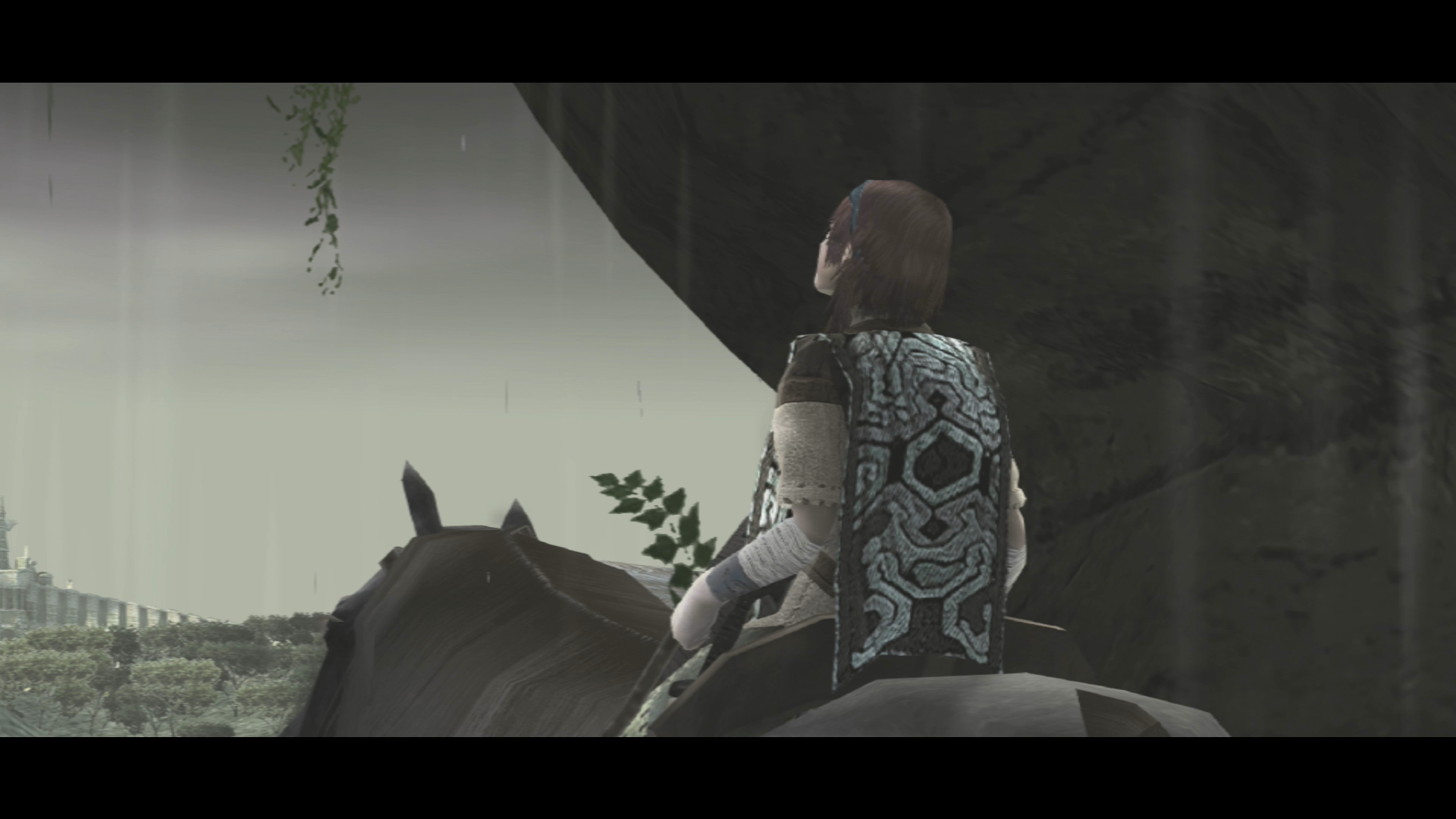
Duration: 4s
Shot type: Medium close up
Camera angle: Below eye level
Camera movement: Tracking
Transition: Fade to black.
Description: Wander sits atop Agro in the center of frame, and stares up at something, likely the sky. On the left is the gate, half obscured but visible in more detail. The camera rises slightly to keep focus on the character. In the last second-and-a-half, Agro lifts her head into the frame and shakes her mane.
Notes: Initially, I thought this was merely a close up of the previous shot. I also thought the camera was static, as in the two preceding shots.
But the movement, so minor as to be nearly imperceptible, changed my interpretation of the shot from one of waiting to the understanding they need to continue moving, regardless of the weather, which Agro can be seen to confirm by shaking off the water.
Shot #12
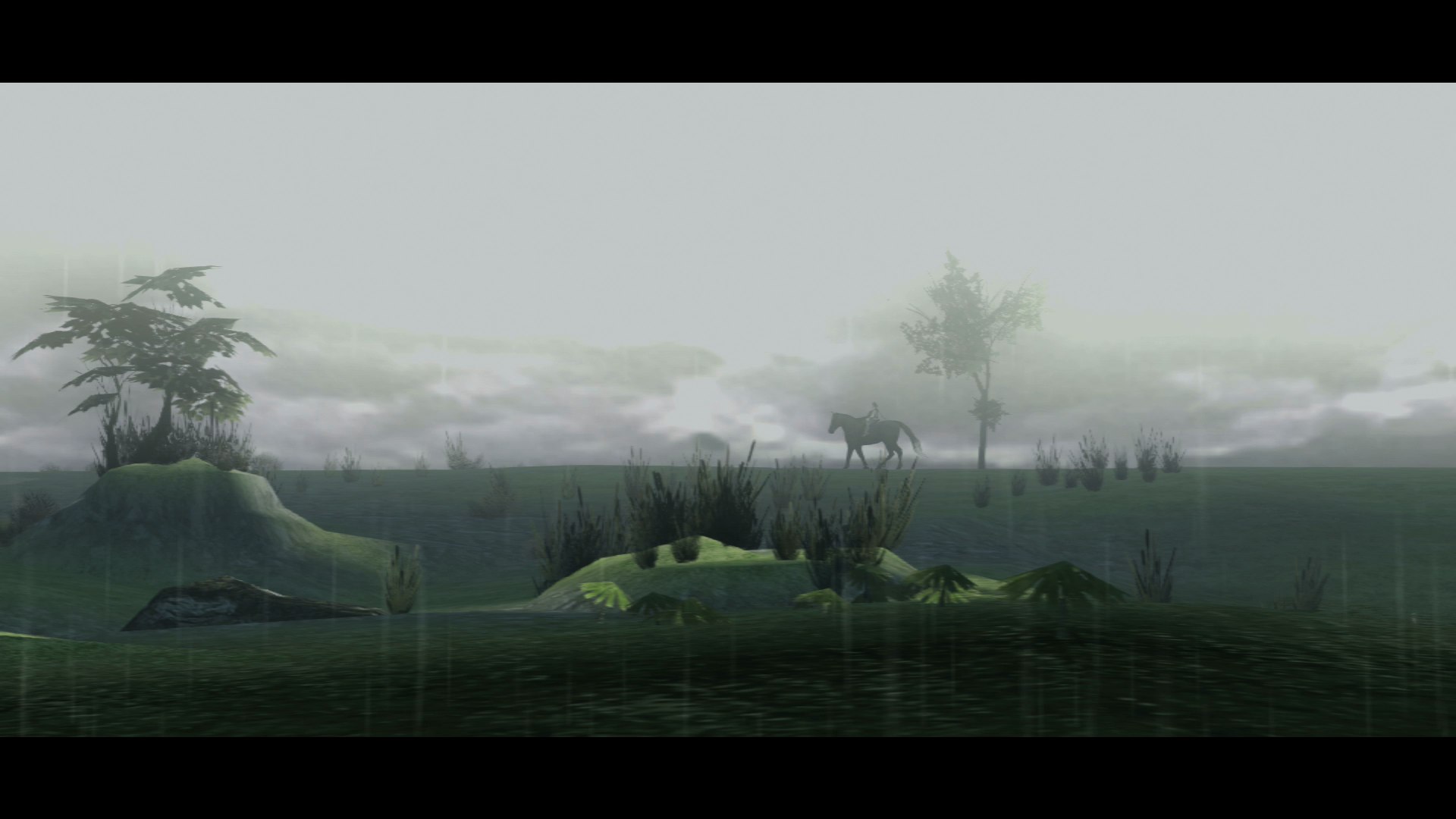
Duration: 10s
Shot type: Very wide
Camera angle: Eye level
Camera movement: Tracking (following)
Transition: Fade to black.
Description: The horizon divides the frame in half. The camera tracks left as Wander and Agro, silhouetted against the sky, walk across a plain dotted with trees and grass. It is still raining.
Notes: Visually this shot is similar to #6, although the space is now more open and the camera is farther away from the subject. The fade from the previous shot implies passage of time, but the rain and clouds suggest this occurs shortly after Shot #11.
This composition (divided frame with figure silhouette) is often used in filmmaking and photography. It evokes imagery of the First and Second World Wars, particularly the photos of Ernest Brooks[6], but also Saving Private Ryan (below) and Band of Brothers[7].
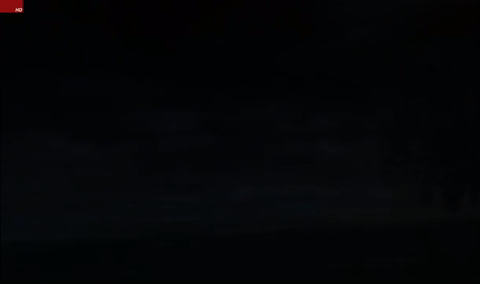
Shot #13
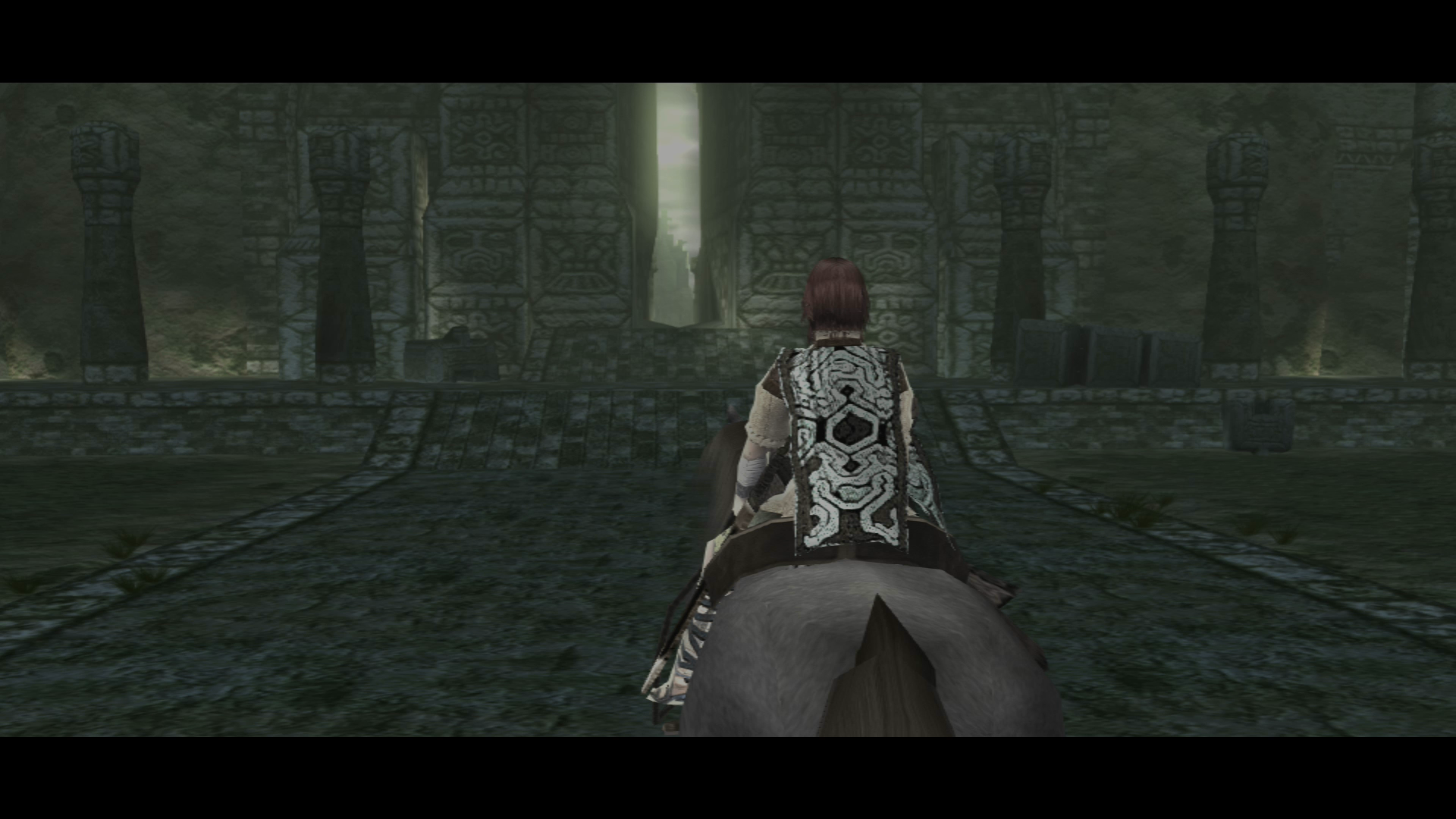
Duration: 9s
Shot type: Medium close up to medium to wide
Camera angle: Eye level
Camera movement: Tracking, panning
Transition: Cut
Description: The shot begins with Wander’s back filling the center of the frame. He and Agro walk toward an opening in an ornate wall (the gate)with columns flanking it, while the camera tracks slightly left. It then pans up to show the gate’s two towers, strongly backlit by the sky and slightly blurred by a bloom effect, and continues to pan until they are nearly out of frame.
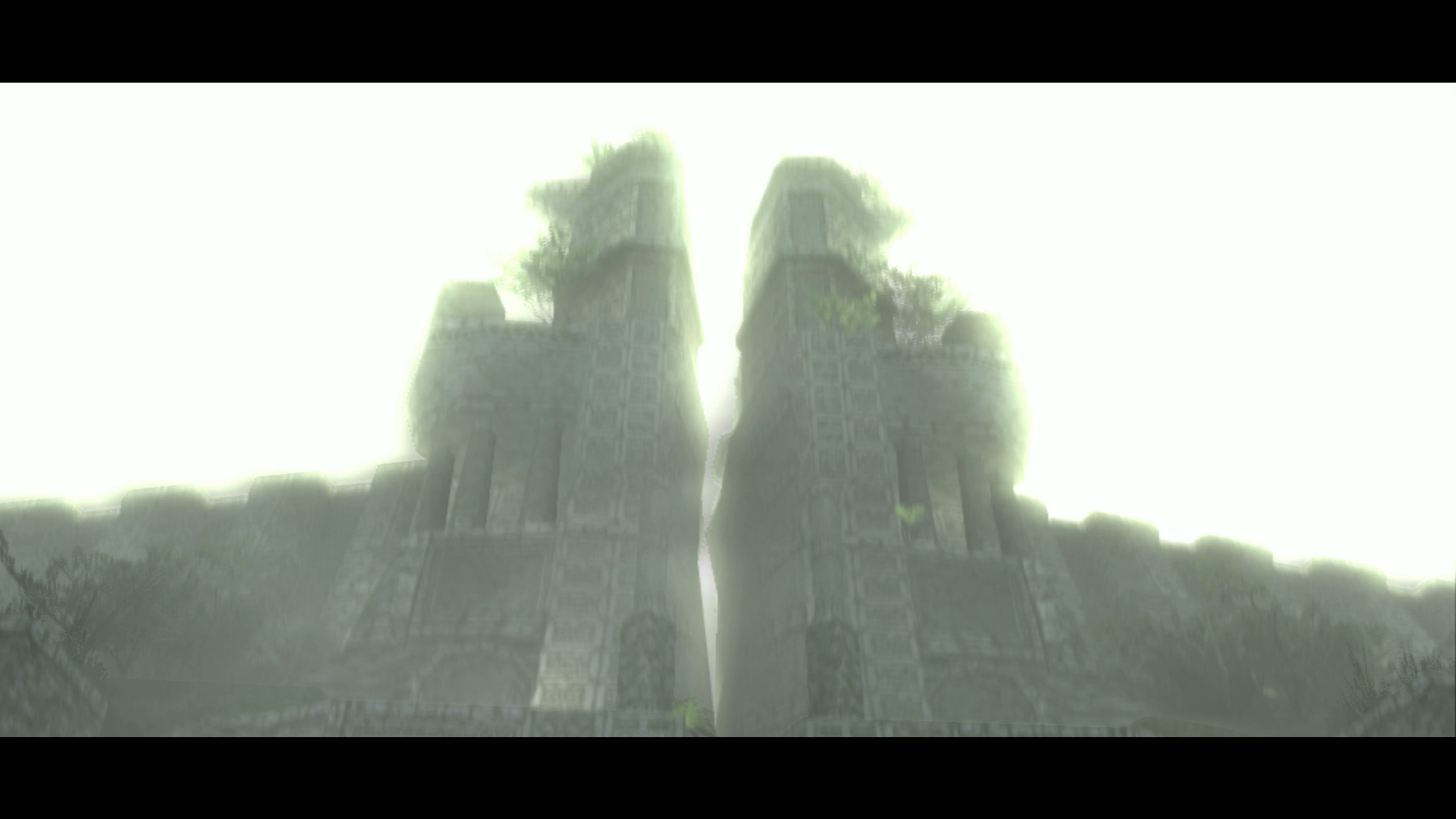
Notes: This is the player’s first good look at the structure Wander has been moving steadily toward, yet it’s only one step on a longer journey, which this shot hints at. The angled lines of the stone path, the vertical walls of gate, and the bright sky beyond draw attention to another building even farther away: The Shrine of Worship.
The fade from the previous shot and the fact that it has stopped raining imply more time has passed.
The continued pan up is designed to showcase the immensity of the walls and towers, to make them seem looming and imposing. Seen in full, it also projects a sense of great age – the stonework is weathered and trees have grown on the various ledges and terraces.
It’s worth noting that the entrance to the Forbidden Lands is unbarred and unguarded. I suspect that the arduousness of the trip and strong local superstition is barrier enough to keep people from wandering in.
Shot #14
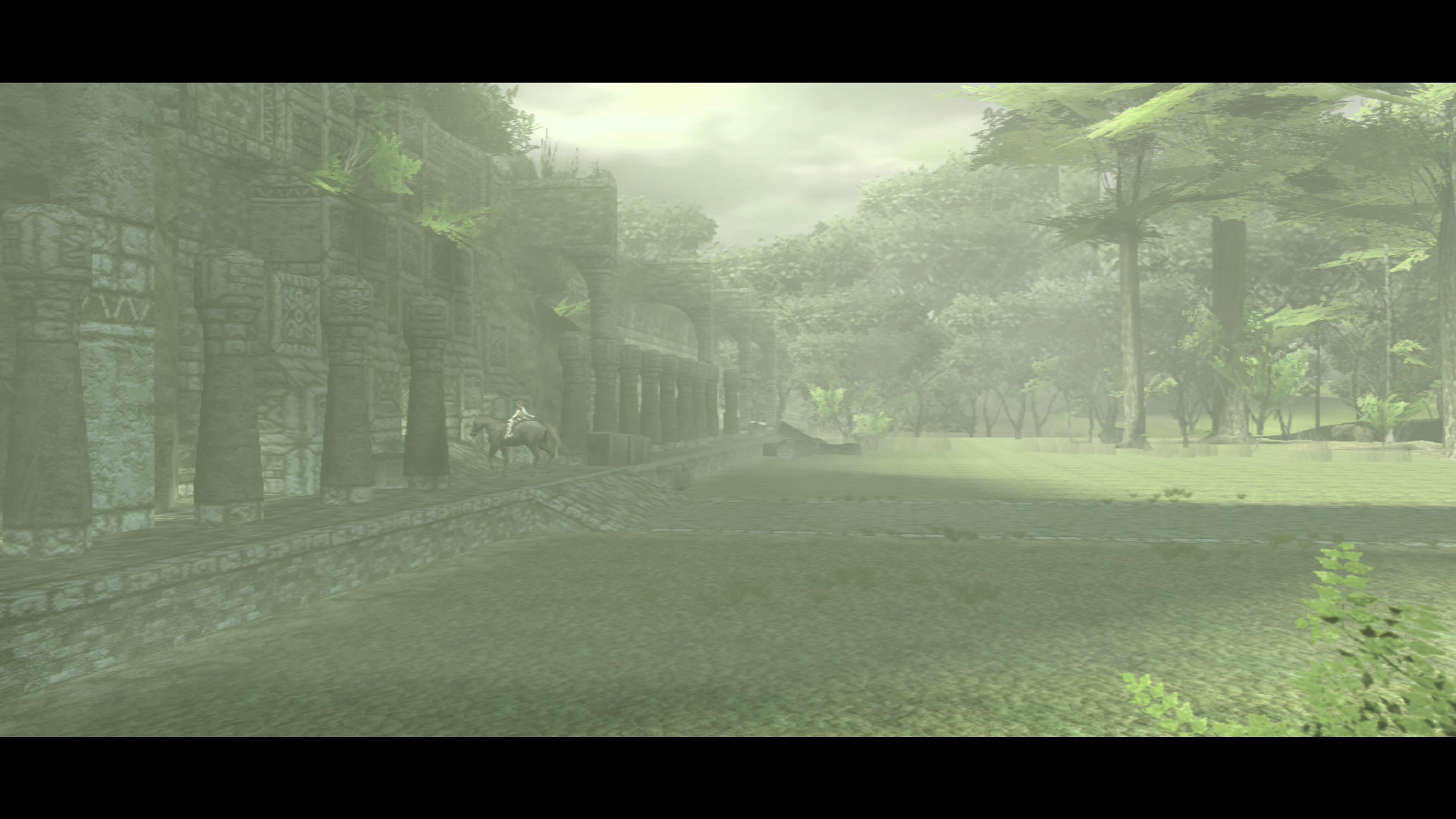
Duration: 9s
Shot type: Very wide
Camera angle: Eye level
Camera movement: Panning
Transition: Cut
Description: The camera slowly pans left as Wander and Agro ascend the stone ramps and enter the cleft, disappearing from view.
Notes: There is a strong sense that this shot and the previous one are building toward something, which will be revealed in the next. Composition and editing combine to create anticipation.
Fans have noted that the number of columns visible here correspond to the number of colossi in the game – 4 on the left, 9 on the right, 3 fallen on the ground, for a total of 16[8].
Out of all the beautiful shots in the cutscene, this one is my favorite. I love the play of light and shadow, the lushness of the foliage, the use of one-point perspective, and the way the frame is divided between the natural world on the right and the man-made on the left (although nature is reclaiming it).
Shot #15
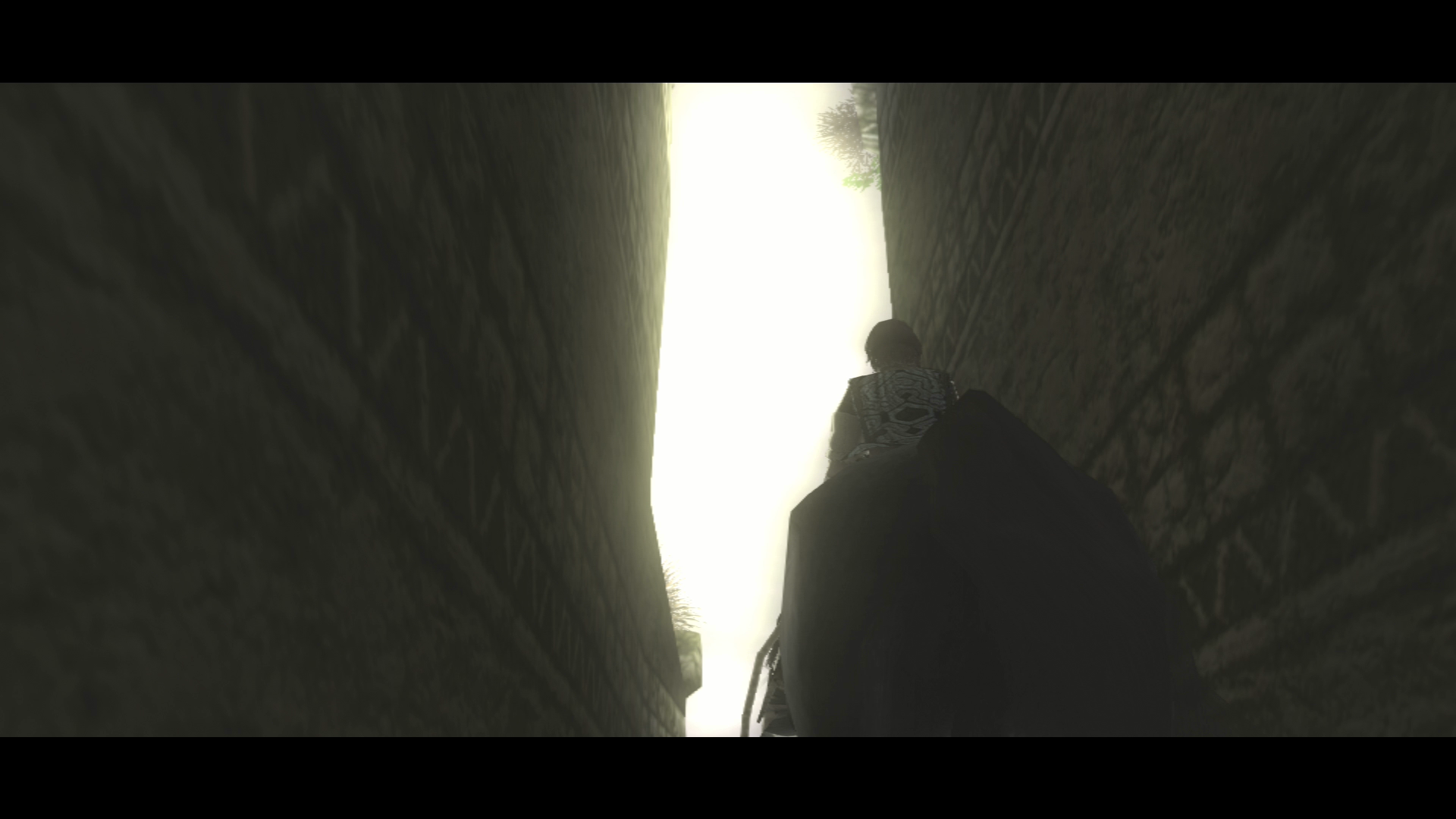
Duration: 29s
Shot type: Medium to close up to full to extreme wide
Camera angle: Low to eye level to aerial
Camera movement: Tracking, panning
Transition: Cut
Description: The shot begins from a low angle pointed toward the sky, dollying forward and to the right. The high walls of the gate fill frame left and right, creating a slit of overwhelmingly bright light. Agro’s head enters the frame from the lower right, followed by Wander’s foot, and then Agro’s hindquarters. While still moving forward, the camera tilts down to center them as they pass beyond the walls and step out onto a large platform, with a vista of the Forbidden Lands filling the frame. The camera continues over their heads to show an impossibly long stone bridge leading to the Shrine of Worship, then lazily pans to the right to focus on the sky.
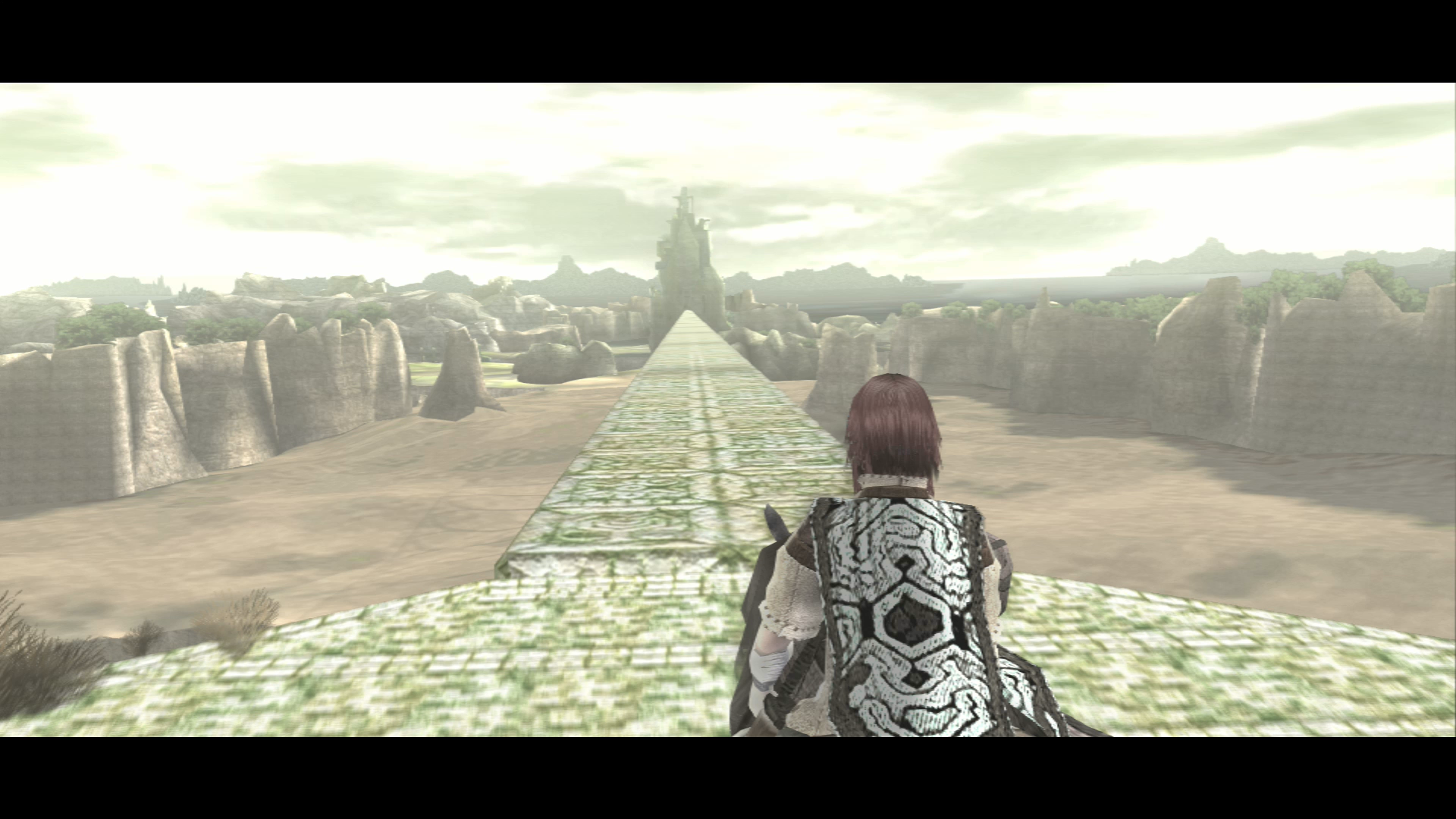
Notes: This is the most complicated shot in the entire sequence, but also arguably the most important: the reveal of the Forbidden Lands. The camera is constantly moving and the framing shifts the subject from the gate, to the characters, to the landscape, and finally to the bridge and shrine.
Interpreted through the lens of Joseph Campbell’s The Hero with a Thousand Faces (also referred to as “the hero’s journey”), SotC shares many stages of the Departure phase of the monomyth[9], although not in the order Campbell described.
We do not see stage one, The Call to Adventure (or potentially stage two, the refusal), but we assume Wander must have some reason for undertaking this journey. Stage three, Supernatural Aid, represented as the Ancient Sword which acts as the player’s compass, and stage five, The Belly of the Whale, will not be seen until after this cutscene when the player has started a new game.
That said, this shot is the embodiment of the fourth step of The Departure, which Campbell calls The Crossing of the First Threshold.
“With the personifications of his destiny to guide and aid him, the hero goes forward in his adventure until he comes to the ‘threshold guardian’ at the entrance to the zone of magnified power.”[10]
The “threshold guardian” could be the gate, and “the zone of magnified power” aptly describes both the function of the Forbidden Lands (to seal dangerous magic away from humanity) and the player’s objective (to kill the colossi and take their essence).
Lastly, worth noting is the change in the musical score that accompanies this shot. The strings, which reached a crescendo in Shot #13 during the reveal of the gate, are joined by a chorus, which sings with something bordering on awe. One would think, during a crucial moment like this, that the music would swell to signal our arrival but, by keeping it reverential and subdued, it is implied that we are now on sacred ground.
Shot #16
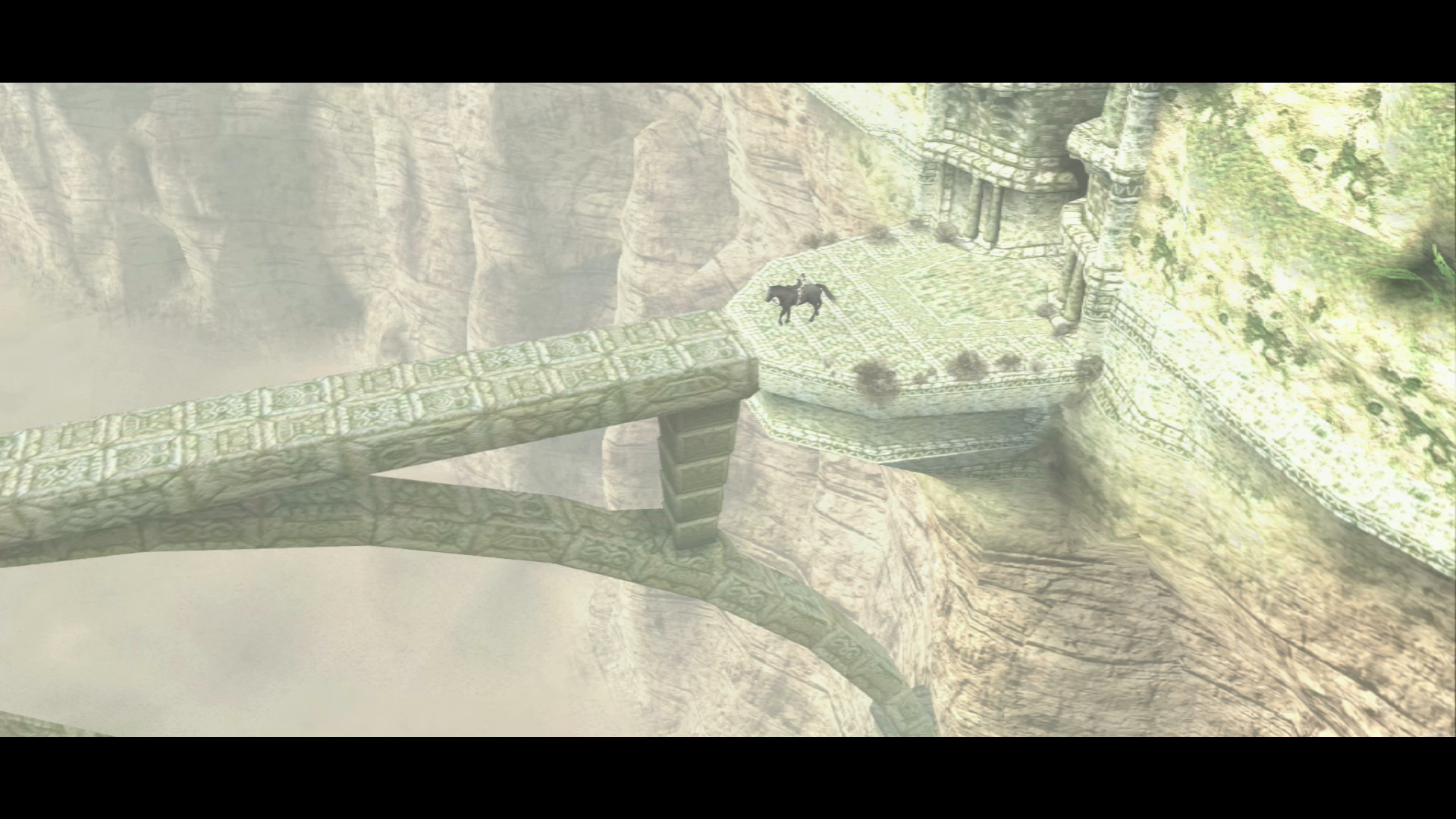
Duration: 39s
Shot type: Extreme wide shot
Camera angle: Aerial
Camera movement: Tracking, panning
Transition: Cut to menu.
Description: The shot starts from a high angle, looking down on Wander and Agro (who are almost completely washed out by a bloom effect) and the bridge. As the exposure corrects, we see them step out onto it, while the camera tracks backward, as if attached to a helicopter flying away from them. For the rest of the shot it continues to pull back, revealing the other side of the gate, as well as the absurd length and height of the bridge. After only a few seconds, Wander and Agro are nothing but a dark speck, and yet the camera keeps moving until, once more, it pans up – the bridge disappearing from the frame – to look at the sky.
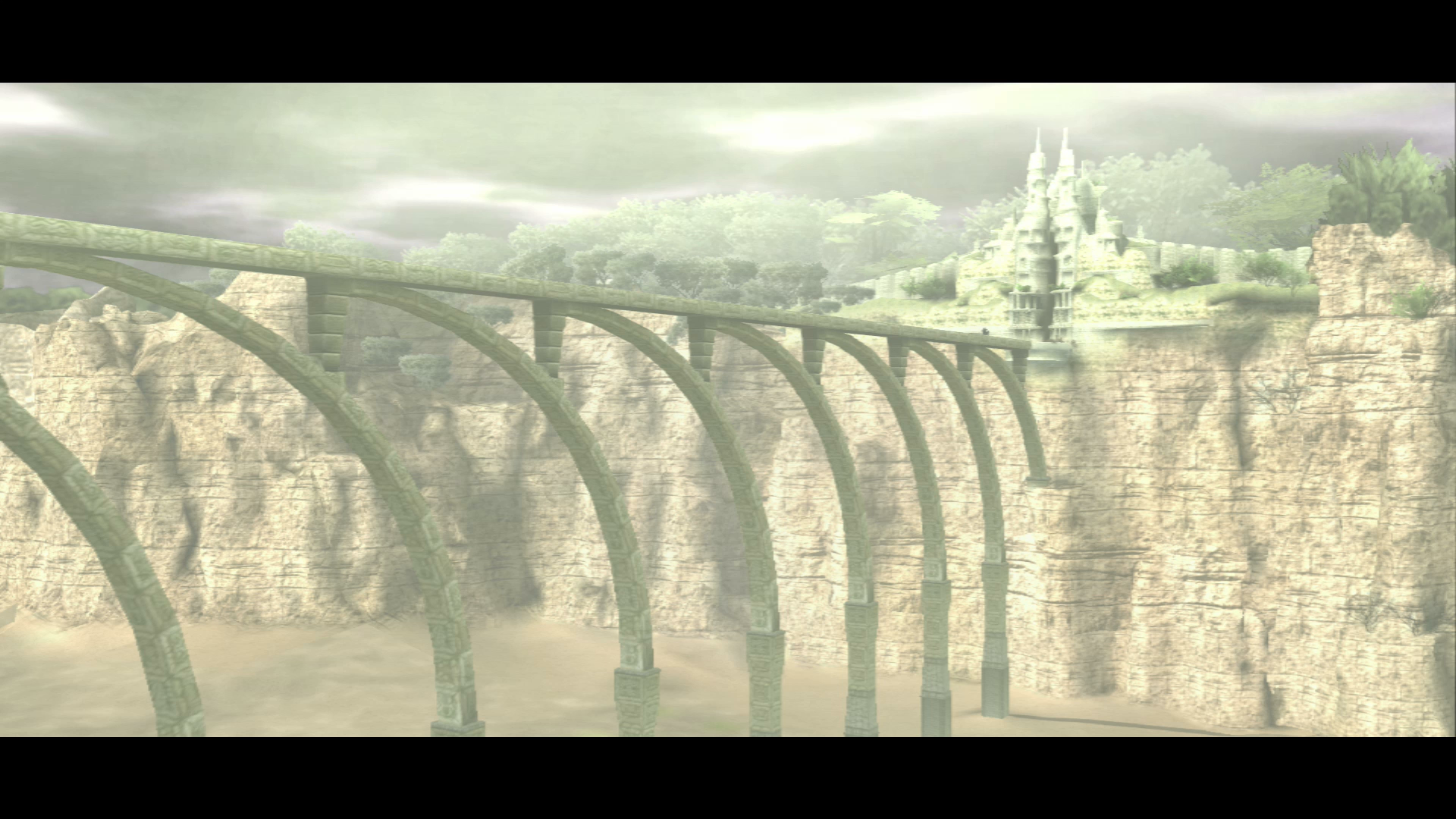
Notes: I believe this shot is here to communicate the sheer scale and grandeur of the Forbidden Lands. Who built this bridge and how? Are there no lengths to which Wander will not go to accomplish his mission?
It is also a manifestation of the American idiom “a bridge too far”, meaning “an act of overreaching”. It is difficult to say whether the developers intended this interpretation, given the different languages, but it perfectly suits the game.
CONCLUSION
As I stated at the beginning of this essay, Shadow of the Colossus’ introduction is successful because of it how sets up everything that follows. The bridge in the final shots and main menu is not just a literal connection between the outside world and the Forbidden Lands, but a metaphorical link between this scene and the next.
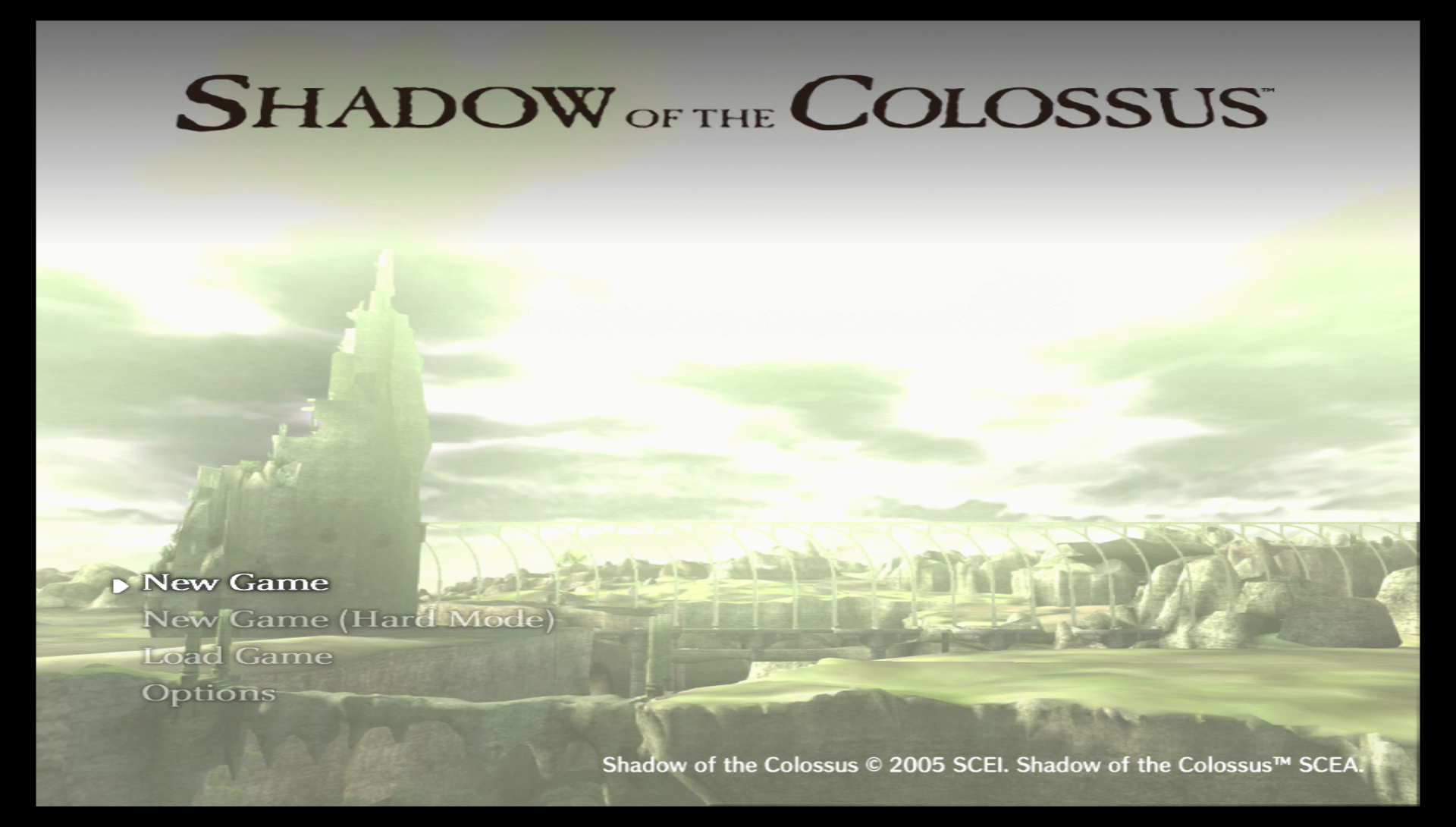
The elapsed time between inserting the disc and gaining full control of Wander is only fifteen minutes, but in that time the game tells the player everything they need in order to play for the next several hours without interrupting to deliver more exposition.
But SotC withholds its greatest revelations until the end of the game. The arrival of Lord Emon, a shaman who leads a party of soldiers pursuing Wander, flips the player fantasy and hero’s journey upside-down. Only after defeating the final colossus, does the player learn that Wander is a thief, that the Forbidden Lands are actually cursed, and by killing colossi to revive Mono he is both destroying himself and unleashing an ancient evil. Shadow of the Colossus is one of gaming’s few tragedies. Though players are ostensibly tasked to save the princess, the game asks them to consider whether the ends justify the means.
Between the use of explicit and implicit storytelling, cutscenes and colossus battles, tranquil setup and tragic ending, Shadow of the Colossus combines the narrative and gameplay elements that survived its subtractive design process to create a deeply engaging experience that remains worthy of study even ten years after its initial release.
ACKNOWLEDGEMENTS
Thanks to Richard Rouse III for his feedback on this article.
[1] Lore-wise, Mono is never officially named in the game or the accompanying manual, and Wander’s name only appears in the Japanese version of the title.
[2] https://bossfightbooks.com/products/shadow-of-the-colossus-by-nick-suttner
[3] A video is available online here: https://youtu.be/yVCQwvzyKJM
[4] http://www.gamasutra.com/view/news/127312/How_Polytrons_Fez_Was_Inspired_By_Uedas_Ico.php
[5] http://www.glitterberri.com/shadow-of-the-colossus/artbook/the-ending-made-clear/
[6] Ernest Brooks, “Troops moving up at eventide – men of a Yorkshire regiment on the march” http://digital.nls.uk/first-world-war-official-photographs/pageturner.cfm?id=74546492
[7] https://en.wikipedia.org/wiki/File:BandofBrothersIntertitle.jpg
[8] http://nomads-sotc-blog.blogspot.com.au/2011/07/intro-cut-scene-green-field.html
[9] https://en.wikipedia.org/wiki/Hero's_journey
[10] Joseph Campbell, The Hero with a Thousand Faces, p. 64
Read more about:
BlogsAbout the Author(s)
You May Also Like







.jpeg?width=700&auto=webp&quality=80&disable=upscale)








